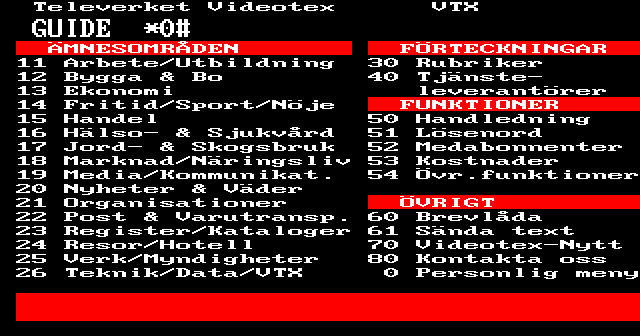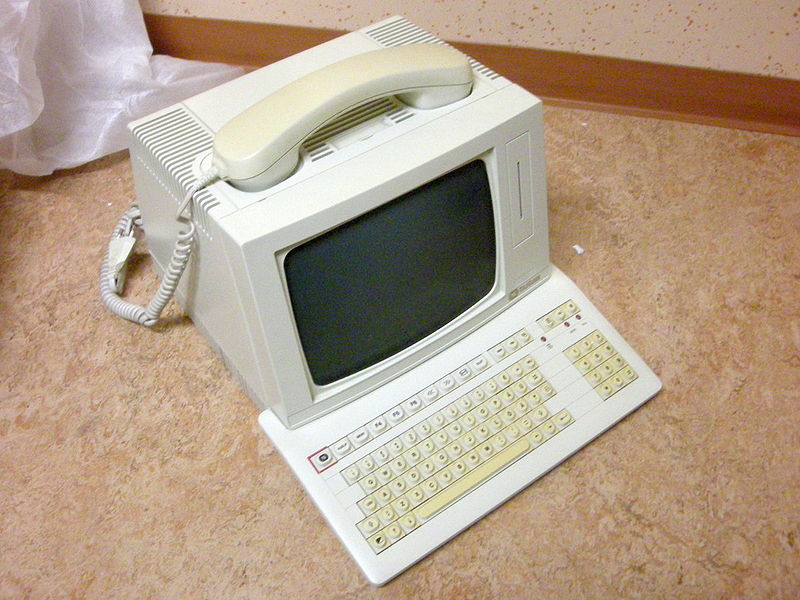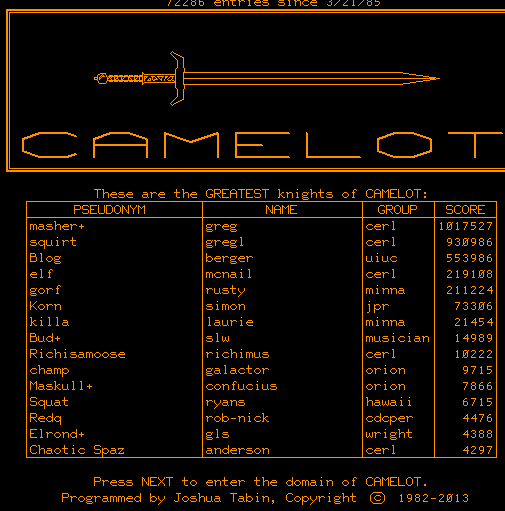Pungenday, the 67 day of Confusion in the YOLD 3186
Videotex and online services
HOPE 2020 is going on. I watched a talk about Bildschirmtext, the German version of Videotex, aka Datavision, aka Prestel systems, aka CEPT.
I've hated these systems with a vengeance. So much wasted possibilities. So much wasted money.
I believe Videotex or Datavision was the first online experience I ever had. Like many times before I had taken the bus with a friend some 60 km to the nearby city of Sundsvall to drool over some home computers. The state-owned phone company Televerket had a shop where they, believe it or not, were selling home computers at the time! I believe they had Spectravideos!
On this particular trip they had a Datavision demo going. It may have been on a specially made terminal hooked to a TV set.
Datavision was launched in Sweden in 1982. I think this Sundsvall trip might have been in 1983. It was already showing its age. It looked like stone age even then. It changed name to Videotex in 1984 and then to TeleGuide in 1991 before mercifully being retired in 1993.
To access the system you couldn't use an ordinary terminal or terminal emulator. You had to use a special Videotex program or specialised Videotex hardware, typically hooked up to your TV set. It had its own character set and didn't use ASCII or a national version, like almost everyone else.
That it couldn't be accessed with a normal terminal was one of my main complaints about the system. If it had had some graphics like its North American cousin NAPLPS or even the amazing PLATO system this might have explained the need for a special program, but no, no such thing.
The system was menu oriented. All pages were arranged in a tree structure and identified by a number. This was another sore point. Fucking menu systems. Still hate them.
Each page view could incur a cost. It was also metered per minute.
There was very little interactivity. Most of the interactivity was menu choices. The text was something like a typical home computer, 40 columns. Very few rows. No graphics. It looked something like this, although this shows the later Videotex start menu:

If you've ever seen Teletext on your TV, it looks very similar.
You usually connected with split speed modems at 1200/75 bit/s. Like most people I type a lot faster than 75 bit/s but that wasn't a problem, of course, because the only thing you ever did on this annoying system was typing in menu options or page numbers.
At the time there were very few services available, so it was even more meaningless. There was not even a phonebook, which is one thing the related French Minitel system did right: they made a digital phonebook the first service and gave away terminals instead of physical phonebooks. Seems like a smart move.
I later borrowed my first modem from a teacher. I had nowhere to call to, so I just called Videotex. I actually managed to find a sort of test account after a few tries and just looked around. Nothing really interesting. And the user experience truly sucked. When I later rented a modem from Televerket in 1986 or -87 I never called back.
Note that this was at a time when the Fidonet network had already started. Even in Sweden some of the first Fidonet BBS's was started in 1985: Sun City Fido and Day Rainbow in Karlstad.
Here's part of a nodelist of Fidonet in Sweden from 1986, the earliest I could find:
https://www.joho.se/2009/10/08/fidonet-nodelist-october-3-1986/
I remember calling Yellow PC in Stockholm in 1986 or 1987. That may have been the first BBS I ever called.
This means that even in the hobbyist world people were having much better service (world-wide e-mail!) and a lot nicer experience than Videotex using simple terminal programs and probably with decent, sharp screens with 80 columns, not fuzzy TV sets.
Then, of course, there was KOM, the grand old man of conference systems, which was open to the public with a lower price if you were a member of a computer club. KOM was like a huge multi-user BBS running on a nice PDP-10. It was expensive, even as a computer club member, but wow, what a service.
I don't know if there were any general timesharing systems open to the public in Sweden at the time. Most universities had PDP-10s running TOPS-10 or TOPS-20 and VAXen and the like, but was there something available to the general public in Sweden?
I found some nice pictures of the Swedish Videotex system behind the scenes at Thom Jaxhagen's web site:
http://jaxhagen.se/videotex.html
He writes that the first generation were Data General Eclipse S/280 systems with S/140s as communication computers. I think most of the pictures are of Data General equipment. I'm a bit surprised it was running on 16 bit minis.
He writes it was later replaced by an IBM system and mentions BTX. Perhaps the same setup as Bundespost's Bildschirmtext? He doesn't mention what kind of IBM hardware but my guess is something from the S/370 line. Does anyone know? I've asked him, but no reply yet.
Imagine using those systems directly instead of having that awful Videotex system between you and the systems? Yes, of course you could have done some menu system or some special shell, but still use ordinary terminals or terminal programs.
Imagine at least a proper e-mail service, perhaps even networked. Imagine forums. Imagine chat rooms! I bet that would have been popular considering how popular Televerkets Heta Linjen, their casual conference call service was. Imagine at least some text games? MUD! Software libraries! Alas, no such thing.
The really crazy part is that Televerket kept at it and relaunched the service in the 1990s by renaming the service "Teleguide" and distributing specially made terminals. They even had some success this time because of some contracts with actually usable services, like a TV guide and a used car part market, among other things, but it was, of course, doomed to fail. Rumour has it that they spent 2 billion SEK on the damned thing.

I remembered reading about a promising alternative to the CEPT standard, NAPLPS, in an early issue of BYTE Magazine. While searching for that article I found that they made a an entire special edition on Videotex (including NAPLPS) in 1983:
https://archive.org/details/byte-magazine-1983-07
but the much more technical article about NAPLPS I remembered is here (Part 1 of 2):
https://archive.org/details/byte-magazine-1983-02/page/n201/mode/2up
NAPLPS sounds much nicer than CEPT given its graphics support and might have actually been interesting to use in the 1980s. USAian friends tell me this was the base for the Prodigy online service! That seems a bit late.
Or imagine a PLATO system open to the public? Now we're talking! Perhaps several PLATO systems networked together?

Alright, the CDC Viking 721 terminals were USD 2,295 in 1982. A little steep, perhaps, but there were PLATO terminal emulators for at least a couple of home computers in the 1980s.
Here are the PLATO terminal protocol specs.
If I understand correctly there were two university PLATO systems in Sweden for a while, one in Umeå and one in Stockholm. Does anyone know anything more about these?
I really liked Brian Dear's book "The friendly orange glow" about PLATO. You can experience a PLATO system yourself at:
Here's another PLATO system with a focus on retrocomputing with lots of PLATOTERM emulators for different computers:
Technical data about the protocols
- CEPT
- BYTE Magazine article on NAPLPS
- Michael Dillon's NAPLPS specs (formal standard X3.110-1983, not free).
- PLATO terminal protocol specs